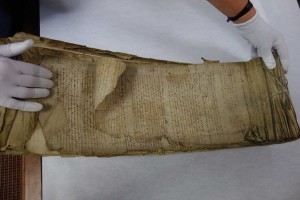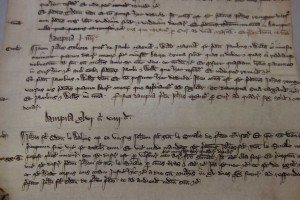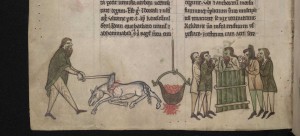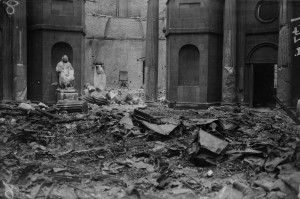Free Gaelic people in English Ireland, c. 1250–c. 1327
Published in Features, Issue 6 (November/December 2015), Medieval History (pre-1500), Volume 23WITH THE SEPTCENTENARY ANNIVERSARY OF THE BRUCE INVASION OF IRELAND THIS YEAR, PERHAPS IT IS RELEVANT TO ADDRESS A TOPIC OFTEN ASSOCIATED WITH THE INVASION: THE REMONSTRANCE OF THE IRISH PRINCES.
By Stephen Hewer
The Remonstrance was a petition sent to Pope John XXII in c. 1317 that contained a list of grievances by Domhnall Ó Néill against the English presence in Ireland. The Remonstrance claimed, among other things, that the experiences of the various Gaelic peoples were universal under English rule, and that the settlers denied all Gaelic people access to the English courts and prevented the Gaelic chiefs from becoming accepted members of English society.
‘… [In the English courts in Ireland] any Gaelic person, whether cleric or lay … is denied from bringing any court actions by that very fact’ (i.e. being Gaelic).
This claim sat well with many modern readers, and absolute discrimination against the Gaelic people was widely accepted. We would be better equipped, however, to understand medieval society in English Ireland and its internal relations with the Gaelic inhabitants if this petition was treated like an editorial in a newspaper, meant to incite emotions with liberal use of hyperbole.
‘Lack of evidence’?
The reality is that while there were unfree Gaelic people in the English-conquered and held areas, there were also free Gaelic people living in English Ireland. Many historians have discounted their existence because of a ‘lack of evidence’.

The surviving, intact, medieval court roll from Justiciar John Wogan’s court, 1312–13. Such court records left by the English administration show us how English law in Ireland was actually applied in practice. (NAI)

A close-up of the same roll concerning two court cases from County Cork, a writ of unjust detention of goods and a writ of trespass. (NAI)

Another example of medieval hyperbole—Gerald of Wales claimed that a Gaelic king mated with, and then ate, a horse. (NLI)

The wrecked main hall of the Four Courts. Most of the original medieval court rolls were destroyed on 30 June 1922 in the explosion there of the Public Records Office (PRO), which had been mined by its anti-Treaty IRA occupiers. The court roll featured on page 14 had been consulted by a researcher shortly before and had not yet been returned to the PRO and so escaped destruction. (NLI)
Some have theorised that any and all free Gaelic people were hidden under English names, and others have thought that they were disseised (removed from their lands) before the surviving court records were made (1252). On the one hand there is evidence for many ‘Anglicised’ Gaelic people in English Ireland, such as John son of John (‘FitzDermot’), great-grandson of Domnall Mac Gilla Mo Cholmóc, king of Uí Briúin Chualann, south of Dublin. On the other hand there is a great deal of evidence, previously neglected by historians, for the existence of free Gaelic people in English Ireland with Gaelic names. This evidence may be found in the court records left by the English administration, which show us how English law in Ireland was actually applied in practice.
Only persons of free status could win a case in the English royal courts in Ireland. In addition, the English did not allow unfree people to hold free lands. They were clear on this fact when in 1261 the itinerant court at Limerick took the house and goods of David Goer in Killone, Co. Limerick, simply for being unfree. He had not lost a case, he had not been defeated by a plaintiff; he simply was unfree and the house was taken ‘into the king’s hand’. We can compare his treatment with the fate of nine men from County Kerry in 1252. Thomas son of Thomas Cradoc accused these nine men of disseising him of his lands, but the court ruled that the lands belonged to the nine defendants. Four of these men had Gaelic names: William Dun (Donn), Gillin Dun (Giolla Eoin Donn), Gilbert Ofynan (Ó Fionnáin) and Raghenild Omolkeran (Raghnall Ó Maoil Chiarán). They were left in peaceful possession and Thomas was fined for a false claim.
While in the previous case the English royal court took a passive role, in some it actively confirmed that the Gaelic people involved were free and that the courts and administration would protect them. In 1260 Robert Duf (Dubh) recovered six acres in Cloncrayth, Co. Cork, from the abbot of Tractan and Maclachelin (Mac Lochlainn), a brother of the house, after the latter two had illegally and recently disseised Robert. In 1261 Neel Ocrofthelhyn (Niall Ó Criomhthainn?) recovered twenty acres from Hugh de Anton and Robert David in Gortenchauely, Co. Limerick, for the same reason. In 1290 Elena Scolog (Mac an Scolóige?) and her sister Agnes recovered a house and five acres in Clonerkyllethan, Co. Limerick, from Rhys Clon. Their father, William Scolog, had been officially recognised as the rightful owner, and sometime between his death and the court case Rhys had taken their inheritance. In 1302 Richard Scolog, son of Henry Scolog, recovered eight acres in Fanleoston, Co. Cork, from John le Flemeng, which John had taken after Henry’s death. These cases demonstrate that free Gaelic persons were able to win property cases in the English royal courts in Ireland.
Gaelic Irish in positions of power
Free Gaelic men also held positions of power. In 1252 Bricius Ocohelan (Breacán Ó Cochláin) appeared in the itinerant court at Limerick as the attorney for Leliath. In 1280 Edmund, son of Henry de Roche, sued Anna, the widow of John de Cogan, at the Dublin Bench. Edmund’s court representative was John Obut. In the same Dublin bench session Philip Odrey (Ó Draoi) represented Henry Hog in a civil case relating to the illegal use of force. In 1285 Emmeline, the widow of Hugh de Aston, sent Hugh Oglawth and Adam Oglauth as her attorneys to the Dublin bench, and they were received by the bench after the king of England, Edward I, confirmed their suitability. Attorneys at that time were not the same as solicitors or barristers today, but they would have spoken the same language as the justices of the courts and known the court procedures.
A few cases indicate that sheriffs of counties and seneschals of liberties hired Gaelic men to serve as their deputies, as part of their royal or franchisal retinue respectively. In 1295 James Omattus (Ó Mac Cass?) was sued along with William de Valence, lord of Wexford, and Gilbert Sotton, the seneschal, for exceeding their administrative powers. The next year John, son of John son of Henry, seneschal of Wexford, William Nivel, Maurice de Caunteton, another seneschal of Wexford, and Daniel Omathus (Ó Mac Cass?) were sued by Gilbert de Sutton for the same reason. In 1302 James Omaccus—probably the same man from Wexford mentioned above—was fined for seizing the goods of a man outside James’s jurisdiction. James was gaoled, but was released on promising to pay his fine of 40 shillings. The record also mentions that James was the sergeant of Dublin, and that he summoned and distrained men to appear before lay and clerical panels. Ó Mac Cass was clearly a deputy of the English administration, paid for his muscle and given legal power and privilege in return.
What happened to them?
We may never know what happened to the majority, but we can see the disappearance of some. A few Gaels who were recognised as free members of English society did not produce a male heir, and their lands passed to an Englishman when their daughters married. Around 1250 Domhnall Ó Longáin held Loughane in Bohillane, Co. Cork, from Richard de Carrew of Castlecor, and gave Loughane and Sleveen with his daughter Raghnailt to Philip son of Tancard Cristofre before 1260. Diarmaid Mac Carthaigh held the cantred of Glinshalewy in chief of King Henry III (directly from the king, probably for military service). After his son Cormac died, his three daughters and their husbands claimed all of his lands. Robert Cusyn and Rathenild (Raghnailt) seized most of the lands, and then David de Prendergast and Dernorguyl (Dearbhorgaill) and Thomas de Kaninges and Edina (Étaín) sued Robert and Rathenild for two-thirds of the cantred.
A case from Waterford in 1253 partially reinforces the old anti-Gaelic discrimination theory, but not entirely. A jury reported to John, son of Geoffrey, the justiciar, that six Gaelic men holding in chief of King Henry III should be legally disseised in order to place English tenants on the same lands. It believed that the rent of these Gaelic men was too low and that English tenants would be to the benefit of the king’s treasury. Some, but not all, of the Gaelic men were subsequently disseised; the rest paid higher rents.
From 1280 to 1300 several Uí Cheallaigh (O’Kellys) sued to recover lands in north County Dublin and east Meath from Englishmen and women. The Uí Cheallaigh were the lords (or kings) of Brega, which encompassed that region. In 1280 Donenald Okelli (Domhnall Ó Ceallaigh) brought a few cases, but the results were not listed and so we cannot tell whether the English courts recognised his rights to Lougher, Duleek, Meath. In 1287 Theobald de Verdon recognised William Okelli junior as the rightful tenant, but William was still unable to regain lands illegally given to a church. The Uí Cheallaigh continued to sue for lands in Brega, but by 1381 the English courts and society had determined them to be unfree Gaelic men and therefore unable to recover the lands.
Land grants
A final way in which the free Gaelic people disappeared was through land grants. In 1263 Thomas O Regan (Ó Riagáin) repaid a debt of 22½ marks to Robert, the bishop of Limerick, by granting the latter all of his lands, burgages and tenements in Clonnawyll and Clonchenn. Cecily, daughter of Donald Oconnean (Domhnall Ó Coinín?), granted Richard Costard 21 acres and a stang of arable land in Maymoch in exchange for 23 marks, a robe and 12d. annual rent. In 1277 Agnes Odurne (Ó Duirn), probably the daughter of Conibyr Odyrne (Conchobhar Ó Duirn), granted twelve acres in Corbally to Thomas de Lega the younger, and Alexander son of Alexander Mol (Maol) sold his rights to 100 acres in Rathno, Co. Cork, to Philip son of Gilbert. Without holding any free land they could have been reclassified as unfree, like the Uí Ceallaigh of Brega, or simply died without heirs. But unless new evidence is discovered we may never know.
The existence of the free and accepted Gaelic people may come as a surprise now, but they were well known to thirteenth-century Ireland. Excluding a few rhetorical claims, only recently has their existence been denied. These few cases cannot be taken as a representation of the majority of experiences. Thirteenth-century society was stratified, and the magnates and prelates did oppress peasants with harsh labour services and denial of access to the royal courts. Nevertheless, the idea that all Gaelic people were treated only one way, or that the ‘Remonstrance of the Irish princes’ was an accurate and objective statement, clearly needs a fresh appraisal and critical analysis of all of its claims.
Stephen Hewer is a Ph.D student at Trinity College, Dublin.
Further reading
J. Gillingham, ‘Normanizing the English invaders of Ireland’, in H. Pryce and J. Watts (eds), Power and identity in the Middle Ages: essays in memory of Rees Davies (Oxford, 2007).
K. Nicholls, ‘Anglo-French Ireland and after’, Peritia 1 (1982).
C. Parker, ‘The internal frontier: the Irish in County Waterford in the later Middle Ages’, in T.B. Barry, R. Frame and K. Simms (eds), Colony and frontier in medieval Ireland: essays presented to J.F. Lydon (London, 1995)
Read More:
IRISH CHIEFS’ AND CLANS’ PRIZE IN GAELIC HISTORY 2016
THE COUNCIL OF IRISH CHIEFS AND CLANS OF IRELAND PRIZE IN HISTORY 2016
















